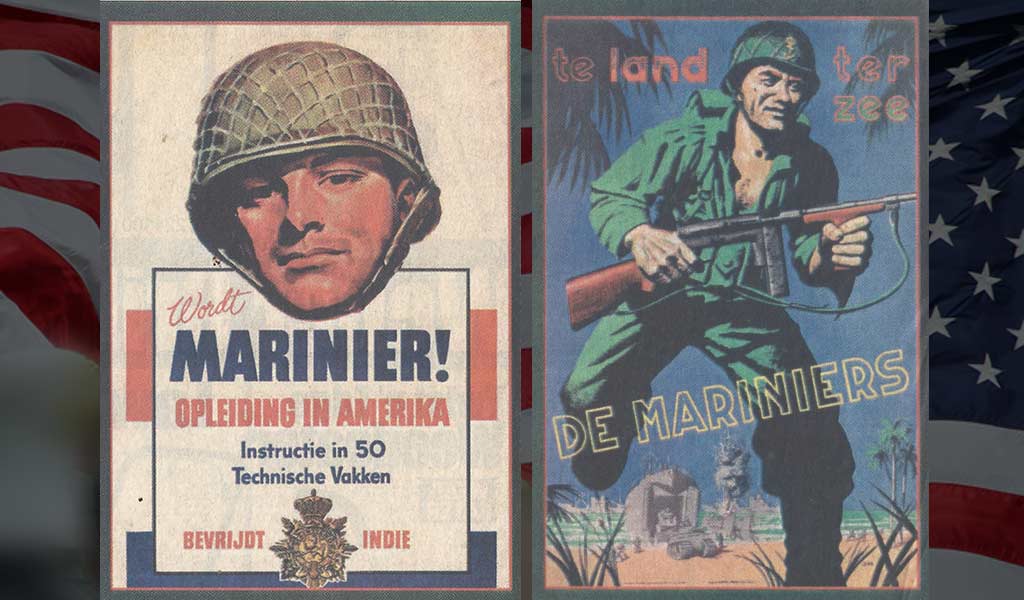The Dutch Marines and Camp Lejeune

On 10 May 1940, the Nazi blitzkrieg, achieving complete tactical and strategic surprise, thundered through and over the erst-while neutral Low Countries. Unprepared, ill-equipped and vastly outmanned, the Netherlands struggled heroically but futilely, collapsing completely by 15 May and surrendering, the royal family and the government having fled to England on the 13th. The scattered remnants of their armed forces, those that hadn’t escaped to England, were in the most part in the Dutch East Indies defending their most prized and important overseas possession. They likewise were over whelmed by the Japanese and surrendered on Java on 9 March 1942.
In the interim, the Dutch government in exile in London strove to reconstitute their ground forces, soliciting assistance from their allies. One of the targeted organizations was the Royal Netherlands Marine Corps (RNMC), a here-to-fore lightly armed, sea-going force with a pre-war strength of less than 2000, but with a proud history dating to 1665. It was in fact junior by only one year to Britain’s Royal Marines, after which it was modeled. Having observed the success of the U.S. Marine Corps (USMC) on Guadalcanal in 1942, the Dutch Naval Minister, however, now contemplated creating a self-supporting, combined arms, reinforced regiment, using a USMC template and considered a brigade, to be a better model for a proposed mission of conducting amphibious operations in furtherance of recapturing the East Indies from the Japanese.
The minister approached the Combined Chiefs of Staff, which acceded to the plan and forwarded it to the Joint Chiefs of staff (JCS) for consideration and which likewise concurred. The JCS then directed the U.S. Marine Corps on 9 October 1942 to prepare for the training and
equipping of approximately 5000 Dutch Marines (known as Mariniers) as necessary to constitute the desired brigade. They were to be identical to U.S Marines in all respects, including arms and equipment, and uniforms, which would distinguishable by RNMC buttons and insignia. Standing-up the brigade would be accommodated under the broad auspices of the Lend-Lease Act of 1941. Camp Lejeune was designated as the primary facility to accomplish this task, thereby establishing another accolade for the Corps’ premier amphibious base: the only facility in the United States to reorganize and train a complete foreign military organization.
Camp Lejeune was built to serve as a division training base. With the decision by the Joint Army-Navy Board in early 1942, however, to essentially limit the Marine Corps to the Pacific Theater, the 1st Marine Division was the only division trained there. Camp Lejeune’s wartime mission thereafter was to serve as a training center for individual replacements, specialists and smaller Marine units. With the departure of the first echelon of the division in May of 1942, followed by the second in June, the base was considered the best site for the training of the RNMC.
Prospective Dutch recruits began straggling into the United States during the summer of 1943; a disparate lot: former airmen, soldiers, sailors, and Mariniers, from the surviving remnants of the decimated armed forces, from the scattered garrisons of the remaining Dutch possessions, and civilians that had managed to escape from their homeland. Officers were sent for training initially to Quantico. But, the vast majority of all training was conducted at Camp Lejeune, with the exception being certain specialized occupational fields that required training at other sites, such as construction at the Navy SeaBee base at Quonset Point, or for tank, antitank and amphibian tractor training at Camp Pendleton. These initial trainees became the instructor cadre for the subsequent arrivals. The inherent problems in teaching even basic level subjects to the trainees was met by scouring the Corps for Dutch speakers and enlisting them in the effort. There was some friction at the onset with the more seasoned trainees, veterans of the resistance in Holland and combat there and in Java, who chafed at requirement to undergo basic training but, they soon fell into step for the opportunity to join what was perceived to be an elite force and take the fight back to the Japanese.
Meanwhile, the Dutch Army was proceeding with the organization of a mechanized brigade in England, the Princess Irene Brigade, and saw in the detachment of Mariniers under training at Camp Lejeune a ready source of highly qualified personnel. In April of 1944, in a setback to the RNMC’s efforts to organize their own brigade, a significant number of Mariniers were siphoned off and directed to England while the remainder remained in training. To the Dutch Army’s regret, the Princess Irene, despite its augmentation, was not combat ready by D-Day on 6 June, and was not able to land on the continent, in France, until 7 August. The Mariniers remained with the brigade, participating in the Allied advance through northern Europe until they were permitted on 1 April 1945 to rejoin their detachment at Camp Lejeune. Others elected to remain in Holland, which was liberated on 5 May, to support a rigorous recruiting program to entice volunteers for service in the RNMC. With the recruiting effort shifting into high gear and being met with enthusiasm, the Commandant directed Camp Lejeune to prepare all necessary facilities for the expected arrival of several thousand new recruits.
Camp Lejeune at this point was approaching closure on two chapters of its unique and illustrious contributions to Marine Corps history: the training of the women Marines, then known as Marine Corps Women Reservists (MCWR, or just WR), and the training of black Marines, at Montford Point. WR occupied two areas, the WR Battalion area, which housed permanent WR personnel assigned to the base, and the WR Schools area in Regimental Area 1, both at Hadnot Point and on opposite sides of the Main Service Road, now McHugh Blvd. Area 1 had been occupied by WR Schools since replacing the Parachute Battalion there in 1943. With the MCWR rapidly approaching its allotted strength of 18,000, recruitment was being deemphasized and WR Schools was experiencing a decreasing enrollment. Barracks and buildings in Area 1 became available and were designated for RNMC use. By April 1945, the area was being shared by both WR and Mariniers, and the former WR Recruit Depot Building (114) was now the headquarters of the RNMC Detachment. By July, 3429 Mariniers were in training in the United States, the bulk at Camp Lejeune, and additional space was still required.
There was one other major military base located in Onslow County, Camp Davis, the first and largest of the Army’s seven Antiaircraft Artillery Training Centers (AAATC). Its main post area of 5590 acres stretched some 4 ½ miles along U.S. Highway 17 approximately twenty-five miles south of Camp Lejeune and across from the town of Holly Ridge. Including its five artillery ranges and maneuver areas, a total of 44,434 acres was available for training the forming RNMC brigade.
As the war progressed through 1944, the Army realized that they had greatly overestimated their AAA requirements and began closing AAATCs with Camp Davis being shuttered on 1 October. Since the camp was a temporary, leased facility, it was then offered to any other government organization that might be interested. The United States Army Air Forces (USAAF) was interested, obtaining possession on 1 February 1945 with the intention of developing the camp into a Redistribution and Convalescent Center. But, then again, it became apparent that after $1,600,000 had been spent in redevelopment, the planned center represented and unnecessary and excess capability; the Marine Corps was approached. Camp Davis was an obvious and serendipitous answer to the billeting and training needs of the RNMC brigade. Camp Lejeune assumed the lease on 19 August and began moving the Mariniers out of Area 1 on 5 September.
By the end of October, the Dutch had 4880 Mariniers in training, mostly now at Camp Davis, and were able to stand up their brigade, designated the 1st Brigade, RNMC, as was intended in 1942. And, as originally conceived, it was constituted and equipped under USMC tables of organization, consisting of a headquarters and service battalion, three rifle battalions, an artillery battalion, a motor transport battalion, an engineer battalion, a service and supply company, a tank company, an amphibious tractor company, a medical company and special intelligence units. Now combat ready, they were ordered to the Dutch East Indies to tend to colonial affairs as their former colony strove for independence in an active insurrection. The brigade displaced from Camp Davis in two echelons for Norfolk, the port of embarkation, beginning in November and sailing on the 12th of that month and on 11 December for Java, where they joined other allied forces in a developing, vicious colonial war. Camp Lejeune held onto Camp Davis briefly, using it for the staging of material being returned from the Pacific until it was turned over to the U.S. Navy on I June 1946.
After four years, the Dutch, unsuccessful in their counterinsurgency, relented, withdrew their forces from Java in 1949, granted the new nation of the Republic of Indonesia its sovereignty, and sent the Mariniers to Western New Guinea, the status of which was still unresolved. There the Brigade remained until 1962, finally returning to its homeland after twenty years. The Mariniers subsequently underwent several reorganizations with the Brigade ceasing to exist as such in the 1970s, assuming its current configuration as a smaller, 2300-man, elite infantry component of the Royal Netherlands Navy, serving worldwide as an expeditionary, rapid reaction and special operations force. The “Korps Mariniers,” having risen like a phoenix from the ashes of virtual annihilation, and the U.S. Marine Corps, who resurrected them from extinction, maintain a close, fraternal bond and Mariniers can still be seen periodically training at Camp Lejeune.
REFERENCES
I.J. Baron Lewe van Avard. “The Determined Amphibian.” Gazette, Feb 1946.
“British Continue Batavia Cleanup,” New York Times, 31 Dec 1945.
“Camp Lejeune.” Marine Corps Historical Center. Located in Operations and Training Division Historical Files, Headquarters, Marine Corps Base, Camp Lejeune. (c. 1946)
Gertrude S. Carroway. “Dutch Marines,” Camp Lejeune Leathernecks-U.S. Marine Corps Training Center, Camp Lejeune, NC. New Bern: Owen G. Dunn Co, 1946.
- Ernest Dupuy and Trevor Dupuy. The Encyclopedia of Military History. New York: Harper and Brothers, 1970.
LtCol H.W. Edwards, USMC. “Netherlands Korps Mariniers,” Gazette, Sep 1953.
LtCol George Egli, USMC (Ret). “The Netherlands Marine Brigade,” Leatherneck, Jul 2016.
George Garand and Truman Strobridge. Western Pacific Operations-History of USMC Operations in WW II, v.4. History Div, HQMC, 1971.
Sgt Ernie Harwell, USMC. “Dutch Marines,” Leatherneck, Aug 1945.
“Historical Chronology,” Operations and Training Division Historical Files, Headquarters, Marine Corps Base, Camp Lejeune., (c. 1988)
Capt Edwin Klein, USMC. “The Dutch Marines and the Indonesian Problem,” Gazette, Aug 1946.
Pl/Sgt Fonnie Ladd, USMC. “Training of Netherlands Marines Under Command of Marine Unit” Camp Lejeune Globe, 25 Apr 1945.
“Moving Day for Dutch Marines,” Camp Lejeune Globe, 5 Sep 1945.
Capt K.M. Pattee, Q.M.C. “Completion Report for Camp Davis at Holly ridge, NC, July 1, 1941.” War Dept., Office of the Construction Q.M., Camp Davis, Wilmington, NC.
Gordon R. Rottman. U.S. Marine Corps WW II Order of Battle: Ground and Air Units in the Pacific War, 1939-1945. Westport: Greenwood Press, 2002.
Capt John E. Slater, Coast Artillery Corps. “Farewell to Camp Davis,” Coast Artillery Journal, Sep-Oct 1944.
Joseph W.F. Stoppelman. “I Shall Maintain,” Christian Science Monitor, 30 Jun 1945.
Dr. Kristin Szylvian. “Fort Fisher During World War II,” Eastern Office, NC Division of Archives and History, Greenville, NC. (n.d.)
LtCol L.J. Kimball, USMC (Ret) 28 Jan 2021
Posted on: November 3, 2021

